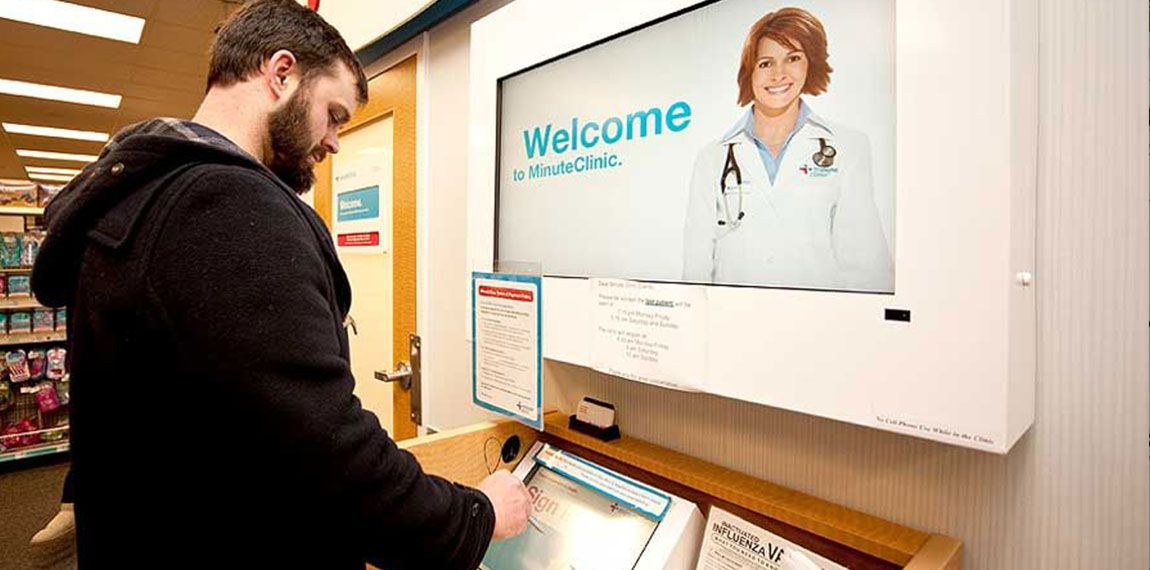How often have health consumers used a self-service kiosk in other industries to increase efficiencies and improve the customer experience? Think about the last time you checked in at the airport or had digital photos developed into prints.
That same technology is coming to healthcare as part of the health consumerism wave. And it’s bearing positive results.
Cleveland Clinic and HealthSpot
For example, Cleveland Clinic has partnered with HealthSpot to provide patient care via private kiosks—armed with medical devices, videoconferencing, and medical assistants—in non-traditional care settings, such as corporate offices, universities, and retail locations. What’s more, this clinical data will be incorporated into the EHR.
When Cleveland Clinic piloted a one-year study of its kiosks at three family health centers, it received an overall patient satisfaction score of 93%, according to The Advisory Board.
Retail Care in the Hospital
Health consumers are increasingly responsible for their own quality and access to care.
“Self-service kiosks reduce wait times, improve staff efficiency, and satisfy a consumer demand for self-service. Interactive kiosks can be freestanding machines like the ones you find at the airport, or portable tablets, and can allow patients to do everything from update their contact information to make payments,” cites The Advisory Board.
Vanguard Urologic Institute
Vanguard Urologic Institute sought to streamline patient check-in, increase collections, and secure pre-visit information by implementing kiosks. It realized four key benefits almost immediately:
- Reduced wait times to an average of two minutes
- Improved collections by consistently requesting co-pays, balances, and insurance eligibility
- Increased focus for registration team on the patient experience
- Integrated patient data via EHR update before practitioners interacted with the patient
Hugh Chatham Memorial Hospital
As the Affordable Care Act rolled out, HCMH experienced more than a 76% increase in emergency department volume. After implementing MEDHOST ED Pass, a registration kiosk, the hospital was able to speed registration and triage to within 10 minutes and immediately screen potentially high-risk patients.
“We were really focused on patient satisfaction and turnaround times, two quality measures that were hard to improve without significant changes to ED operations. With MEDHOST EDIS and ED Pass in place, the improvement to turnaround time was significant, and our patient satisfaction scores increased into the 90th percentile,” said Lynn Kennedy, ED manager.
Their benefits were quantitative:
- Nearly 100 percent of ambulatory emergency department patients use ED Pass to register, providing patients a faster way to communicate their needs to clinicians
- ED Pass scans patients’ drivers’ licenses at the kiosk to provide more accurate demographics
- Patient satisfaction scores soared to the 95th percentile
Challenges with Kiosks
Besides the upfront investment of installing and training team members how to use kiosks, there are several challenges a healthcare system must consider before taking the plunge:
- Some patients prefer face-to-face interaction and don’t want to adopt new technology; low patient portal adoption is a good indicator of this phenomenon
- Staff engagement must be thorough if they’re to educate patients about when and how to use kiosks, and hospital staff must be on-hand to provide help if needed
- User experience is critical for today’s health consumer, who has become accustomed to streamlined hardware and software interfaces in other industries
It’s imperative that hospitals, health systems, urgent care centers, and retail clinics heed the consumer advancement of other industries when it comes to emerging technologies. Kiosks are not only a great way to improve the patient experience, but they’re also a key tool for increasing gross patient revenue and decreasing operating expenses.



